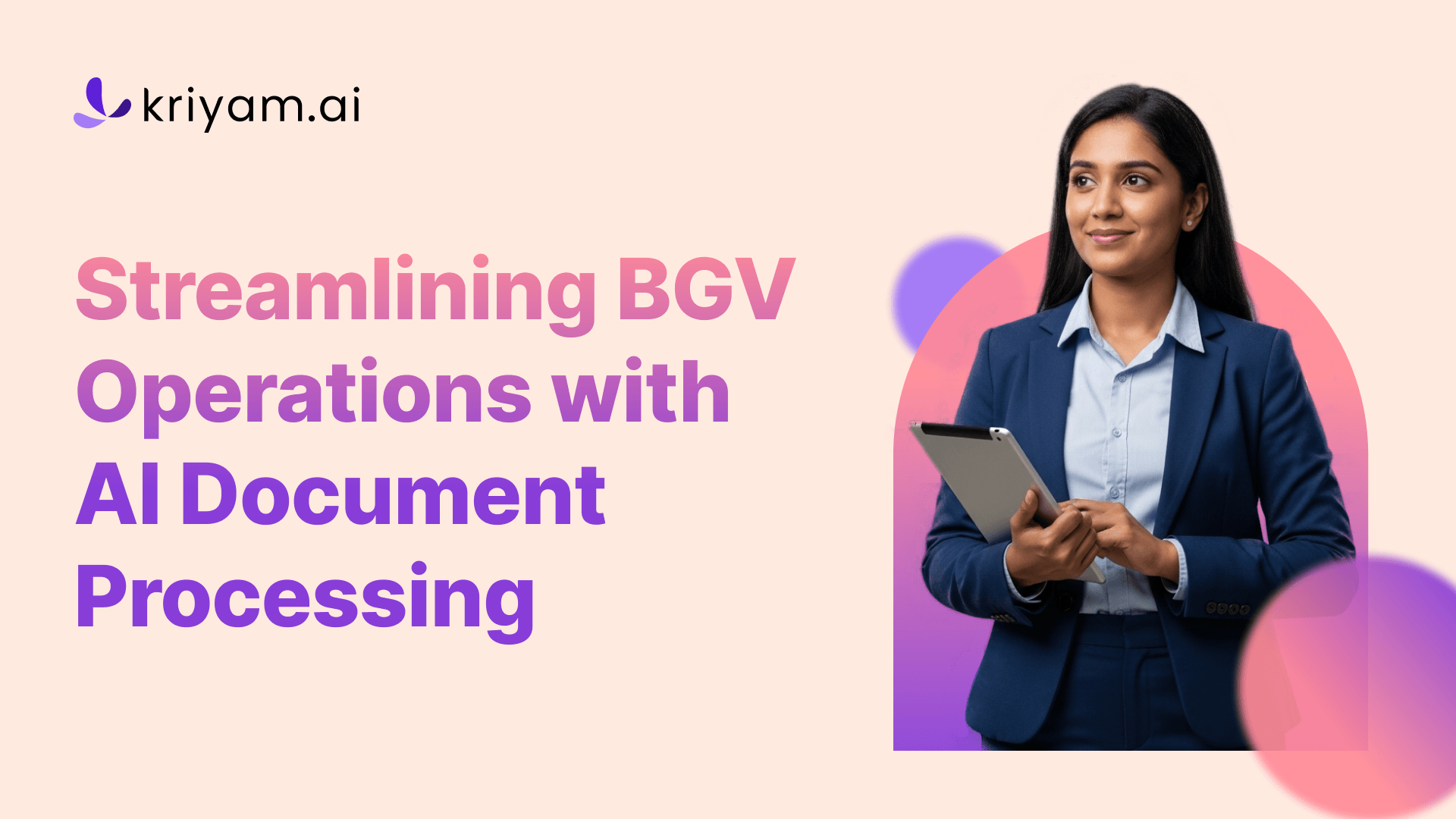How Background Verification Companies Are Streamlining Operations with AI Document Processing
Sharlyn Bedi | 16th June, 2025
4 min reads
Sharlyn Bedi | 16th June, 2025 | 4 min reads

Tired of sifting through endless paperwork and manually verifying each document for accuracy? Welcome to the brave new world of AI-powered background checks. With background verification companies facing a swirling vortex of high costs, accuracy demands, and the need for speed, AI emerges as a game-changer. This post delves into how AI document processing is reshaping the verification landscape, offering impressive efficiency boosts and accuracy rates. Journey with us as we unravel this trend, revealing how AI is not just an option but a necessity for staying competitive.
Introduction
The world of background verification is not without its hurdles. Companies operating in this space often grapple with a trio of significant challenges: high operational costs, a relentless demand for precision, and the ever-present need for speed. It's a lot to juggle, and it doesn't seem to be getting any easier. Perhaps you've noticed this trend too.
Amidst these challenges, a transformative wave seems to be on the horizon: AI and automation. These technologies promise to turn the tide by offering innovative solutions to these persistent issues. AI, with its ability to learn and adapt, offers a level of efficiency that traditional methods often lack. Automation, on the other hand, streamlines processes that were once bogged down by manual intervention. Together, they create a powerful duo.
Interestingly, the adoption of AI in background screening is not just a whisper of potential—it's a roar of change. Indeed, the use of artificial intelligence in this field is anticipated to grow by 27% annually through 2024 (gitnux.org). Such growth signals a significant shift towards automated processes, hinting at an industry that's rapidly evolving. The question is, how will these changes redefine the landscape of background verification? Perhaps only time will tell.
Understanding AI Document Processing
AI document processing. It's a term that might sound a bit technical at first, but it's actually quite straightforward. Essentially, it's about using artificial intelligence to handle documents—everything from sorting and reading to analyzing and verifying them. This technology is becoming increasingly relevant, particularly in fields like background verification, where there's a constant need to sift through mountains of paperwork quickly and accurately.
Let's break it down a bit more. AI document processing involves several key components. First, there's Machine Learning. This is the part of AI that allows systems to learn from data, improving their performance over time without being explicitly programmed for every specific task. Imagine a system that gets better at identifying relevant information in documents just by being exposed to more and more examples.
Then, there's Optical Character Recognition, or OCR. It's a technology that's been around for a while, but AI takes it to another level. OCR turns different types of documents, such as scanned paper documents, PDFs, or images captured by a digital camera, into editable and searchable data. It's like giving a computer the ability to read text from images—a crucial step in digitizing and automating document processing.
Lastly, Natural Language Processing, or NLP, comes into play. This component helps computers understand, interpret, and generate human language. In the context of document processing, NLP is used to analyze the text within documents to extract meaningful information. It's what allows AI to not just read but to actually understand and make sense of the content.
These components work together to automate the tedious process of document collection, analysis, and verification. AI systems can now gather documents from various sources, check them for accuracy, and even validate the information contained within them. It might seem a bit futuristic, but this automation is helping background verification companies operate more efficiently and accurately. And perhaps, it's just the beginning of a broader transformation in how we handle information.
Categories of AI Solutions for Background Verification
In the realm of background verification, AI solutions categorize themselves into several key areas. Each plays a distinct role in enhancing the efficiency and reliability of the process, though the lines sometimes blur between them.
Intelligent Document Processing
AI's role in intelligent document processing is significant. It automates the extraction and validation of data from documents, reducing the manual labor traditionally required. This technology doesn't just speed things up—it can also reduce errors, perhaps even catching those subtle discrepancies that the human eye might miss. It’s fascinating how AI can handle such intricate tasks with high precision.
Automation in Data Gathering
Then there's automation in data gathering. Picture this: a system that pulls in information from various sources, consolidating it into a digestible format without human intervention. It's not just about speed; it's about cutting through the noise to find what truly matters. This streamlining of data collection is, arguably, a game-changer for background verification companies.
Fraud Detection Systems
Fraud detection systems driven by AI are crucial. These systems identify and mitigate fraudulent activities, acting as a vigilant guard against deception. They analyze patterns and anomalies that might suggest something isn't quite right. Of course, no system is infallible, but AI's ability to learn and adapt makes it a formidable ally in the fight against fraud.
Efficiency Gains in Document Processing
AI-powered document review systems are transforming the landscape. These systems can process up to 1.5 million documents per day, dramatically improving efficiency and accuracy in professional services. According to worldmetrics.org, such capabilities highlight the potential of AI to reshape traditional workflows. The sheer volume of documents processed is staggering, and it’s a testament to how far technology has come. There’s something almost poetic about machines handling the mundane, freeing humans to focus on more strategic tasks.
It's clear that AI solutions offer diverse benefits in background verification, though one might argue that the technology is still evolving. The potential for further integration and enhancement remains vast, and it's intriguing to think about what the future might hold.
Benefits of Implementing AI in Background Verification
When it comes to background verification, the integration of AI into document processing brings a host of benefits that cannot be overlooked. One of the most significant advantages is cost reduction. By automating document processing, financial institutions have witnessed a staggering 75% drop in processing costs. This kind of reduction isn't just a number—it's transformative, allowing for reinvestment into other crucial areas of the business. You can find more insights here.
Moreover, AI enhances the accuracy of verification processes. This improvement isn't merely a technical success; it's a game-changer for hiring decisions. Better accuracy means fewer errors, which translates to hiring the right people more consistently. Perhaps you're thinking, isn't this what everyone wants? Indeed, but achieving it hasn't always been straightforward.
Another compelling benefit is scalability. AI allows companies to handle a large volume of background checks efficiently, without the need for a proportional increase in the workforce. This scalability means that as demand grows, operations can expand smoothly. It's like being able to stretch without feeling the strain.
Finally, let's talk about improved accuracy in document verification. AI-driven systems in the insurance sector boast a 95% accuracy rate. This is not just a statistic; it's a reflection of operational excellence. Such precision helps maintain trust and reliability in processes that are often complex and detail-oriented. For more on this, check out beam.ai.
In essence, while AI may not be the cure-all for every challenge in background verification, its impact is undeniably profound. It changes the game, making operations more efficient, accurate, and scalable.
Overcoming Traditional Challenges with AI
Traditional background verification processes, let's face it, often stumble due to their inherent limitations. High error rates plague these methods, resulting in inaccuracies that can have significant implications. It's frustrating, really—manual work is slow, painstaking, and often prone to human error. Processing times drag on longer than necessary, and the manual workload can be overwhelming for teams trying to keep up.
Now, enter AI and automation, stepping in like a breath of fresh air. With their help, manual verification becomes less burdensome. AI reduces the time spent on mundane tasks, freeing up human resources for more critical thinking jobs. It’s a game changer, cutting down the turnaround time significantly. What used to take days can now be accomplished in hours, sometimes even minutes.
One of the most impressive aspects of AI in this domain is its enhanced fraud detection capabilities. AI solutions are incredibly adept at spotting fraudulent documents, automating up to 92% of these checks. That's not just efficient; it’s revolutionary. Such efficiencies translate into a 30x return on investment, according to resistant.ai. That kind of ROI makes investing in AI not just a smart choice, but a necessary one for companies looking to stay ahead.
So, while traditional challenges have been daunting, AI offers a promising solution. It’s not perfect, but it's certainly a step in the right direction. Perhaps, as these technologies evolve, we'll see even more improvements. For now, though, it’s clear that AI is reshaping the landscape of background verification.
Practical Applications and Use Cases
Companies today are increasingly harnessing the power of AI to streamline their background verification processes. Take, for instance, a leading global financial services firm that implemented AI-driven document processing. By doing so, they reduced their verification time from weeks to mere days. This improvement not only accelerated their hiring process but also enhanced the accuracy of the verifications, ensuring that only the most qualified candidates were considered.
Another example is a large retail chain that adopted AI tools to handle the influx of seasonal hiring. They faced a significant challenge in verifying the backgrounds of thousands of temporary staff quickly. By integrating AI, they managed to process applications at a pace and accuracy previously unattainable, resulting in a more efficient onboarding process. This, in turn, fostered a sense of trust and reliability, as employees felt confident that their colleagues were thoroughly vetted.
Looking towards the future, there are numerous prospects for AI in background verification. For example, AI could potentially analyze social media data to detect personality traits or predict job fit, although this raises ethical considerations. Another area is the integration of AI with blockchain technology to create immutable records of verification processes, further enhancing trust and transparency.
These examples and potential developments illustrate that AI is not just a tool for efficiency but a transformative force reshaping how companies approach background verification.
Conclusion
AI in background verification isn't just a trend—it's a revolution. By harnessing AI document processing, companies are not only speeding up operations but also improving accuracy and efficiency. The transformative potential here is significant; it’s like moving from a manual typewriter to a modern computer. Businesses that embrace these technologies can gain a competitive edge, keeping pace with rapidly changing industry standards.
For those still on the fence, exploring AI solutions might not just be wise—it could be essential. Staying competitive means being open to change, and AI offers a clear path to enhanced efficiency and effectiveness. It's worth considering, don’t you think?
About the author
Sharlyn Bedi
Junior Content Strategist
Sharlyn Bedi | Junior Content Strategist
A passionate writer with a knack for automation and process optimisation. Through clear, actionable insights, her content is best for leaders to stay updated on latest trends on technology and automation.
Interests: Business Automation, Process Optimization, Digital Transformation
Content Overview
Unlock AI-Powered Document Extraction
Try It for FREE – Extract Text and Tables in Seconds
Share
FEATURED
Automation
Top 5 Best Field Service Management Software in 2025
Best Field Service Management Software
Shreyas R
27th November, 2023



